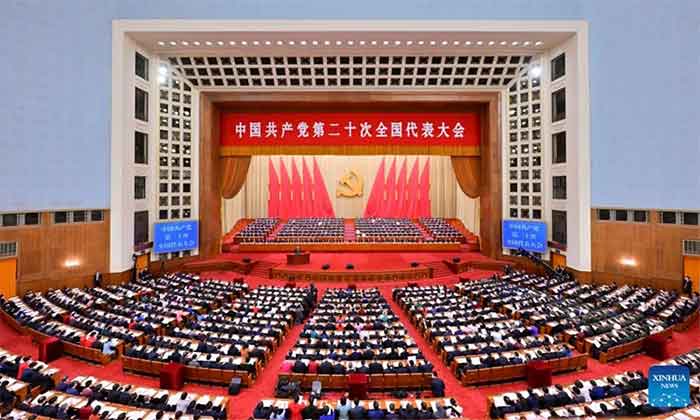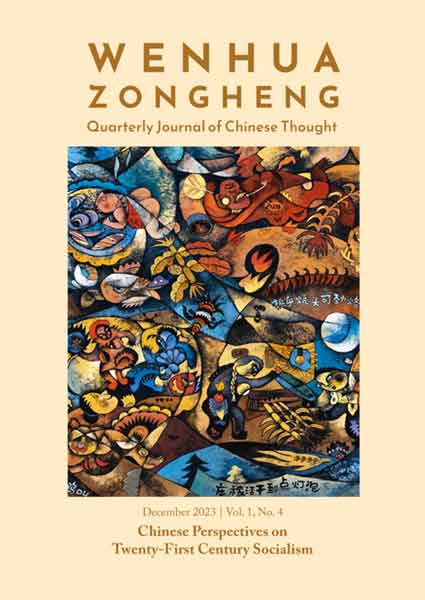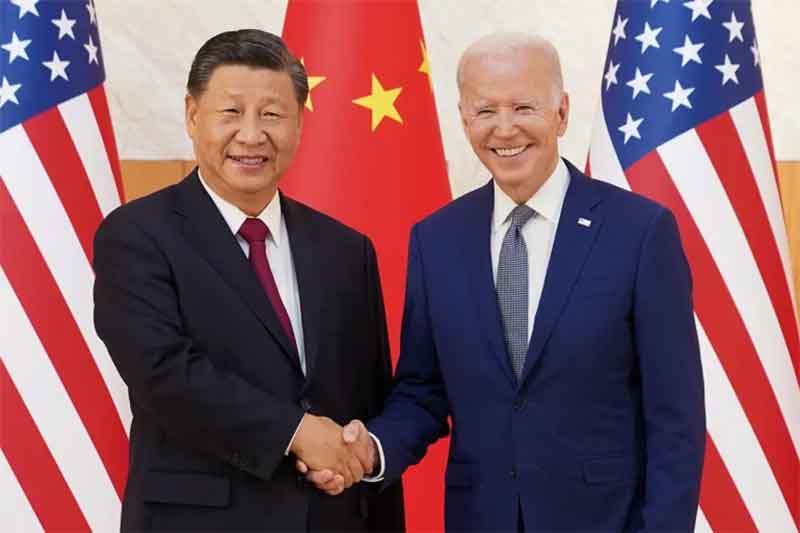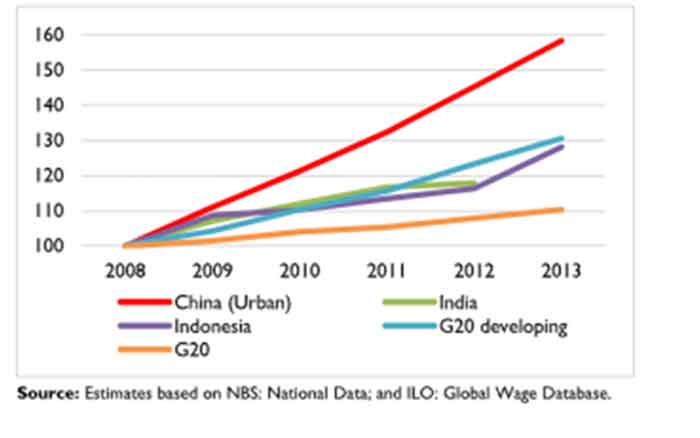
Real wage growth indices in G20 countries, 2008-13, (2008=100)
Source: Estimates based on NBS: National Data; and ILO: Global Wage Database.
*** ***
Media across the world and India is controlled by the pro-west, capitalist forces and it is consistently anti-China in its headlines. ‘Great and big democracies’ almost shun the vast China’s media and its sources, while pouring venom against China, based on distorted information; they are, by conviction, advocates of post-truth. Their basic (and base) purpose is to impose their world view of global loot and hegemony, to discredit the very idea of opposition to capitalism and imperialism and of upholding socialism, by exploiting shortcomings, real or concocted, in their system.
A friend rightly suggested: “There is a need to shed ideological dogmatism, political prejudices, hegemonistic hostility, and view China with open mind.”
The present article is an attempt in that direction, focused on alleged exploitatation of workers in China, to expose the canards in the MSM (‘main stream’ media).Few magazines like countercurrents are contesting such biased stories with a balanced and fair coverage.
Here is a typical view, influenced by the MSM, expressed by a friend, a veteran social scientist: “But it is true that working conditions and quality of life of Chinese workers is in no way better than the working conditions of workers in USA, Europe or India.” Of course it was held by one who, (admitted sarcastically?), “ doesn’t know China and its Socialist Character”.
But one can still see, in the Big Media, even if in small print, China’s achievememts in relation to its people (not merely GDP, which the developed countries, inevitably, must acknowledge).
It may be useful to briefly analyse some issues involved.
China is a developing country with largest population, well known, but not so well known is that it has least resources: It has only 7% of world’s arable land but has to feed almost 25% world population. Of the total world’s arable land of 187 crore hectares, China has 16.52%, US 16.78, India 17.98. US population is only one fourth of China’s but has equal arable land. Still china produced about 500 million tons of foodgrain on around 30 crore acres compared to around 300 million tons of foodgrain on around India’s 40 crore acres.
China thus abolished poverty as acknowledged by FAO, IMF and World Bank, in the shortest span of time, and in an unprecedentd manner in mankind’s history, beating the earlier record of Soviet Union: 80 crore people were liberated from povery in 40 years; that was 70% of world’s poor who came out of poverty (BPL global scale). It was thanks to China’s agrarian revolution and reforms later.
But some people do not see socialism in this; their criteria, perhaps, are otherwise. It may be noted: The Chinese rural areas and masses, on the above foundation, are poised to take off to far better conditions, said economists, as reported by Wallstreet Journal 2020 Nov 17 and CNBC 2021June 28.
China improved rural areas, thus promoting ‘reverse migration to villages as a trend’, reported Business Insider India (2016 May4). This helped reducing rural urban disparities, reported Bloomberg, a leading business news agency of the world. Over 7 million workers thus returned to villages responding to CPC’s call and guidance of 2017 (19th congress), and thus the trend commenced long before Covid (China Daily 2018 Dec 28).
The 19th Congress upheld a new ‘developmet model’ of ‘Not GDP at any cost’ that they felt was needed and pursued earlier; but a model that they said was ‘people-centric’, “sustained, scientific deveopment that is eco-friendly”; and focused on removing disparities- rural-urban, man-woman etc. That was re-defined as the “principal task” of this period, upheld in 2017 Congress by the leadership of Xi Jinping team.
Perhaps that was why the Chinese people and the Communist Party (CPC) that led them successfully for a century, wanted to continue the Xi Jinping team. They amended their regulations to remove the limit of two terms for leaders; the limit itself was introduced by post-Mao China. Earlier, as in Mao’s times, it is well known, that communist leaders had the notion of life-time responsibilities. It was Deng Xiaoping who had initiated the system of retirement, and he himself implemented it. To retain the advantage of the old system, however, the CPC had then devised an Advisory Council of veterans, who help and guide but have no vote in deciding matters.
The Western media distorts it to say Xi is in for a life-time career. They know no better than in terms of careers, factions and caucuses – who serve vested interests, like weapons’ lobbies or pharma lobbies. The word crony capitalism as part of their model of democracy has come to stay. The whole world has seen how US President Trump had crossed all limits, trashed the American election and judicial systems, and threatened to over-rule them.
*** ***
“Real wages in China have been rising steadily over the past two decades” : ILO
Our friend mentioned above typically felt and said: China people’s and workers’ conditions are “in no way better” than those of even India. What is the reality? The above graph is self-evident.
Huge populations of China and India are a factor, often ignored or forgotten, in comparing them with those of other countries, on terms of percapita data.
Still it may be noted: Per capita income in 2017 in US dollars: China 8612, India 1980. Small populations, petro dollars and US-aided technology aided to push up the data as in, for example, Saudi Arabia 20747, South Korea 29958; global loot among other thingss helped USA with $ 59939.
Despite such lower per capita income, China’s workers get relatively better wages, working conditions and have lower working hours:
Extract from ILO Trends Econometric Models, November 2015:
The ILO paper, which contains the above chart, said:
“ Over the past two decades, wages in China have been rising steadily; this has accounted for much of the global wage growth.”
“ The poverty ratio has also declined from 88 per cent in 1981 to 11 per cent in 2010. In 2015, about 60 per cent of Chinese workers were in the middle class. (The definition of middle class is those earning between $5 and $13 per day at purchasing power parity (PPP).
“Rising wages have thus contributed to reducing poverty and expanding the middle class.”
“ China’s wages have thus grown at a faster rate than the average of developing G20 economies.”
“ As a result of its rapid wage growth, China’s estimated average nominal wage (in both urban units and private enterprises) was higher than the average wage levels of other developing economies in Asia and the Pacific in 2014.”
The above study of 2015, was under the joint guidance and supervision, including of an Indian scholar, Sukti Dasgupta. That wages had further gone up after 2015 can be seen in recent data.
China’s public sector workers have far better wage and working conditions, notwithstanding ill-informed or motivated accusations of an exploitative state. The above study further says:
Growth in urban real wages
“ Between 2008 and 2014, real wages in China’s urban units grew at a compound annual rate of 9.1 per cent. For employees in urban private enterprises – where wages are considerably lower than in the public sector – the real wage growth was even faster, at 10.7 per cent per annum. In nominal terms, the 2008 average monthly wage in China’s urban units was 2,408 Yuan Renminbi (CNY) – 69 per cent higher than the average wage of CNY1,423 in urban private enterprises.
“Although the difference has narrowed in recent years, the wage level for urban units remained 55 per cent higher than that of private enterprises in 2014. According to the International Labour Organization’s (ILO) estimates, based on statistics from the National Statistical Bureau (NBS), the total annual growth rate for China’s urban average real wages (both urban units and private enterprises) was nine per cent over the same period (see Appendix I for the methodology). China’s real wages have thus grown at a faster rate than the average of developing G20 economies, (figure 1).
China has been a manufacturing hub of the world, it is well known, but note that the wages have been rising. The motivated accusation of “sweat shops” in China is not objective:
“Real wages in manufacturing have grown by 176 per cent on average between 2003 and 2013. In particular, low-wage sectors have witnessed higher wage growth. These include textiles (242 per cent), furniture (210 per cent), processing of timber and wood (227 per cent) and food processing (216 per cent).”
“ As a result of its rapid wage growth, China’s estimated average nominal wage (in both urban units and private enterprises) was higher than the average wage levels of other
developing economies in Asia and the Pacific in 2014. Figure 2 (see below) provides information on nominal wage levels in US dollars for economies with broadly comparable data, compiled from Labour Force Surveys.”
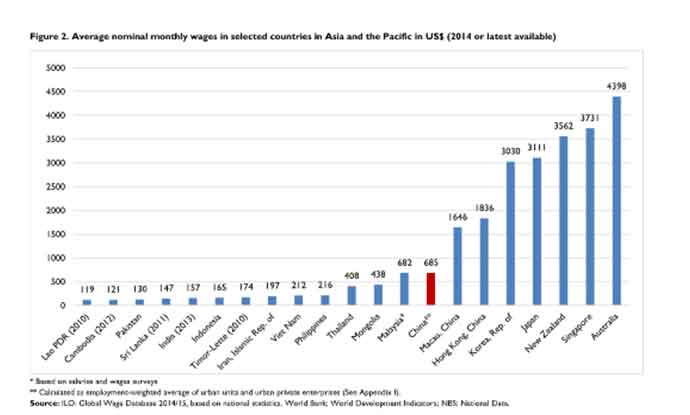
Note that the wages in China are about four times than those in India. Hong Kong and Macao, with far higher wages, though part of China, are shown separately.
*** ***
Wages in China are far better than those in India
A critic wrote about the Chinese labour with “.. the lowest wage rate which is the major attraction on the part of both foreign and domestic capital..” (countercurrents. Org 06/07/2021) He compares labor rates of China, a developing country that was basically agrarian until recently, with those of the West that had industrial and technological revolutions centuris ago, and plundered the whole world so as to sustain a labor aristocracy.
A more balanced and realistic picture of China’s wage rates needs to be seen, and can be glimpsed in this article.
As per international recruting agencies’ data of 2016, in Shanghai, a Skilled worker’s average wage was 9200 dollars per year; Net pay per hour $ 5.4, Work hours in an year 1967. In Delhi, the corresponding figures are: 3100 dollars ; Net pay per hour $ 2.3, 2251hours. Obviously China’s wage rates ( $ 5.4: 2.3) are more than double, and wages almost thrice ($ 9200: 3100), than in India. But our critics are never tired of vilifying China.
In 74,000 companies (70 % of total) in China, inluding MNCs, there are communist party units not to speak of trade unions that are a must. Western media, some years ago, had reported 40,000 to 70,000 protests by workers and others in China in an year; obviouly trade unions (led mostly by CPC) and people have rights to fight for their rights, even while the State allows capitalism, foreign and domestic.
The capitalists know better, than academic scholars, about workers’ conditions.
A Paper was presented at conference on “India and China’s Role in International Trade and Finance and Global Economic Governance” organized by the Indian Council for Research on International Economic Relations (ICRIER), by (IMF and KAF, December 6-7, 2007, New Delhi. Its Abstract says:
“This paper focuses on comparisons of productivity, (unit) labor cost and industry-level competitiveness for the manufacturing sector of China and India. We first provide a comparison between India and China using a broad international perspective. We find that China has increased its labor productivity to a level above that of India, but due to a somewhat higher compensation level, China is still somewhat at a disadvantage in terms of unit labor cost in manufacturing relative to India.”
It tells investors that it is costlier to manufacture in China than in India. MNCs were further told that labor regulations in China are tougher than in India.
A critic of China tells a fact : “Along with Party’s growing hold over Chinese companies, Party supervision of foreign MNCs operating in China has also become regular feature of Xinomics.” (See countercurrents, 26/10/2022).
“Even Walmart, world’s biggest US-based MNC which a few years back was having more than 70 percent of its procurement from China, and which never allowed even unions in its US stores, had to allow party cells in its Chinese stores.” (See countercurrents, 06/07/2021), wrote the same critic. But he derives wrong conclusions from these facts. They indeed shows how even foreign monoply capitalism is leashed in China.
See this comparison too:
Manufacturing labor costs per hour for China, Vietnam, Mexico from 2016 to 2020
They went up between 2016 and 2020 thus: in China from (in U.S. dollars) 4.99 to 6.50, Mexico 3.82 to 4.82, Vietnam 2.38 to 2.99.
Hours worked, in a standard workweek, are 40 hours in China and 48 hours in India, 20% more than China.
https://www.statista.com/statistics/744071/manufacturing-labor-costs-per-hour-china-vietnam-mexico/
Labor force 819.5 million in China is far bigger than in India with 478.3 million.Thus the impact on the over-all economies is significant.
Some other analyses show, as below:
Salaries and benefits: Hourly minimum wage $1.73,is almost 3 times more than India’s $0.61.
Annual wage in China is $ 2,084 in nominal and 3,491in PPP terms, 40 hours per week, 1.68 percent of GDP per capita in July 2018.
India: Annual $ 674 in nominal and 2,498 PPP for 48 hours week. 0.27 percent of GDP per capita in July 2015.
In China RMB 2,420 (US$ 379.77) per month. Turkmenistan US$156 per month. Ukraine in Europe $239.23 per month. Thus China’s are better than those in Ukraine that is part of developed world.
Rate RMB 21 (US$3.30) per hour or $ 26.0 for 8 hours in Shanghai. Thailand ranges from US$10.35–US$11.10 per day and up. It is $10 per day in Kerala. The rate is 2.6 times more than in high-wage Kerala.
The minimum wage in China is set locally; ranges from RMB 1,120 (US$175.76) per month, or RMB 10.6 (US$1.66) per hour in Liaoning; to RMB 2,420 (US$379.77) per month, or RMB 21 (US$3.30) per hour or 26.0 for 8 hours in Shanghai, ie., $ 676 per 26 day month.
“The establishment of minimum wages has been China’s main mechanism to address social inequality,” said the ILO study mentioned above.
In India: Though stipulated by law, it varies from Rs. 348/day (US$4.7), ie., $ 122 per month in Mumbai (2017); to Rs750/- per day or , $10 ie., $260 per month Kerala, as per the same data. It is well known that statutary minimum wages in India are more on paper than in reality.
More than one crore persons are employed in India’s Government and public sector today on casual or contract basis today, as per an estimate stated by a BMS (BJP) leader. Most of them are not being paid the stipulated minimum wages until recently.
*** ***
Number of strikes and mandays lost came down drastically in India
The private sector is worse. The new norms of ‘ease of business’, encouraged by governments led by all parties almost buried the Labor departments’ inspection duties that are supposed to oversee implementation of labor laws. The same holds good for poor safety regulations in industries, as evidenced by so many accidents and huge burden of occupational hazards and diseases.
The new Labor Codes introduced by the Modi regime, and emulated and implemented by all states ruled by different parties, had given the capitalists a field day to loot and suppress workers.
Workers’ strikes are few and far between. Mandays lost due to strikes and lockouts came down drastically over the years.
Man-days lost during 1982 were 88 million because of the textile strike in Bombay; in 1984 55 million man-days were lost; in 1986 on account of strikes and lock-outs was down to 20 million. In 2012 the figure was 2.8 million. During 2018-2020, in three years 3.6 million, or 1.2 million per year.
The figures for 2012 are: The Numbers of strikes 265, of workers involved 1222737, and mandays lost 2849753…all came down, over the years.
“In the last three years, India lost 36.94 lakh man-days in both public and private sectors due to 210 strikes and lockouts, while southern states of Kerala, Tamil Nadu and Karnataka emerged on the top, Deccan Herald reports, citing the data from the ministry of labour and employment.” (Deccan Herald: 12/MAR/2021)
It is well known that millions of workers lost jobs, as lakhs of industries were closed, all the more so during and after Covid. Their wage and working conditions deteriorated, but they lost their rights, and feared to go on strikes.
Sham democracy
Our media and intellectuals shout about lack of democracy in ‘autocratic’ China. The above picture of strikes in India shows how democracy is a sham in India, particularly for toiling masses.
The Indian leaders manipulated democracy, began with toppling elected govt of EMS in Kerala, and eversince imposed President’s Rule more than 100 times, and ruled for long years. India has no tenure or age limits for high offices. But we in India are convinced that China has no democracy!
Indira Gandhi imposed Emergency (1975), suspended all fundametal rights, imprisoned one lakh citizens, and continued in office for a long period, until she was assassinated. Modi regime emulates and excels her, with an undeclared Emergency. But we in India are convinced that India is the largest democracy and China has no democracy!
We have political dynasties who control parties and governments for decades. But we in India are convinced that China has no democracy.
Democracy in India has been reduced into a farce wherein not only voters, but legislators and whole parties are purchased.
The ruling party BJP at the Centre led by Modi purchased MLAs (legislators in states) at around Rs.50 crore per head. It happened, for example, in Karnataka, Goa, Maharashtra.. Latest in Telangana was one Congress MLA (Rajagopala Reddy Komatireddy) was reportedly purchased by BJP by giving him a contract worth Rs 18000 crore, spread over 20 years. He was defeated in a latest bypoll (Munugode Assembly constituency) by ruling TRS party, which now turned into a national party BRS. Together they spent Rs. 500 crore in a constituency with 2.4 lakh voters. Each voter was paid in the range of two to five thousand rupees per vote by both paties.
Still the largest democracy(India) and the ‘greatest’ democracy (USA) join hands in ‘alliance of (bourgeois) democracies’ to weaken and counter China, that has a different model of People’s Republic. It has a model of people’s democracy, where collective leadership is internalized, and topmost leaders were voted out by the Central Committees as in the case of Zhao Jiyang and Hu yaobang.
India had Nehru who was Prime Minister for 18 years over four terms and died at age 75, while in offie. We had PMs, not to speak of many CMs, who were in their late seventees and eightees: Manmohan Singh exited as PM, after a second term, when he was 82. Morarji was 82 when he was toppled as PM. Modi (72) is believed to run for a third time in 2024 to continue in office till he would be 79. But our media and pundits sensationalize that that (an ailing? House-arrested? As per speculations or rumors) Xi Jinping aged 69 becomes a top leader for a third term! And that is autocracy in China! Hypocracy, thy name is India!
*** ***
[for more on on China, on these and allied subjects, see the following articles, in countercurrents.org:
https://countercurrents.org/2021/07/china-communist-party-was-always-a-controversy-part-2/ on 17-07-21
https://countercurrents.org/2020/03/communist-manifesto-remembered-part-2-10-suggested-measures-of-socialism-chinas-socialism/ on 1-3-2020]
(The authot is a political observer, and contributed to countercurrents.org)



